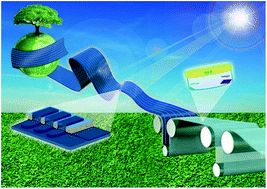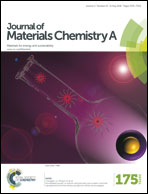Toward environmentally compatible molecular solar cells processed from halogen-free solvents†
Abstract
Replacing toxic halogenated solvents with eco-friendly solvents will be necessary for the upscaling and mass production of organic photovoltaics (OPVs). In this study, toluene (Tol), a halogen-free solvent, was employed in the fabrication of molecular solar cells, achieving a power conversion efficiency (PCE) higher than that obtained when using a chlorinated counterpart, chloroform (CF). SMPV1, a two-dimensional conjugated small molecule, was used as the donor and [6,6]-phenyl-C71-butyric acid methyl ester (PC71BM) as the acceptor to form bulk heterojunction (BHJ) OPVs. The as-cast device formed using Tol displayed a PCE of 5.4%, higher than that (4.8%) achieved using CF. Combining the effects of thermal annealing and polydimethylsiloxane (PDMS) as a solvent additive, the PCEs of devices prepared using Tol and CF reached 6.20 and 5.52%, respectively. Solvent vapor annealing (SVA), a powerful tool for controlling the morphology of the active layer, had a great impact on the device performance. Tol, tetrahydrofuran (THF), carbon disulphide (CS2), and hexane (Hex) were tested as halogen-free solvents for SVA treatment. Tol- and THF-SVA had positive effects on PCEs, reaching 7.04 and 6.50%, respectively. The enhancement arose mainly from the improvement in the fill factor, due to morphological manipulation and favorable phase separation. CS2- and Hex-SVA treatment had negative effects on the short-circuit current density and, hence, the overall PCE. A PCE of greater than 7% is the highest performance reported to date when using a halogen-free solvent to prepare small-molecule solar cells.


 Please wait while we load your content...
Please wait while we load your content...